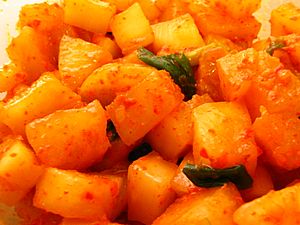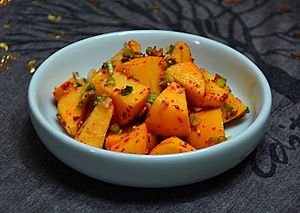Kkakdugi facts for kids
| Kkakdugi | |
 |
|
Quick facts for kids Korean name |
|
|---|---|
| Hangul |
깍두기
|
| Revised Romanization | kkakdugi |
| McCune–Reischauer | kkaktuki |
Kkakdugi (깍두기) is a popular type of kimchi from Korean cuisine. It's also known as diced radish kimchi because it's usually made from Korean radish (called mu in Korean). The name Kkakdugi comes from the sound "kkakduk-kkakduk," which describes the sound of dicing or cubing food. This tasty side dish is enjoyed by many people in Korea and around the world.
Contents
The Story Behind Kkakdugi
The history of kkakdugi is found in an old cookbook from 1940 called Joseon yorihak. This book says that kkakdugi was first made by Princess Sukseon. She was the daughter of King Jeongjo, who ruled Korea from 1776 to 1800.
One day, there was a big celebration at the royal palace. Princess Sukseon brought a new dish she had made by accident. It was made with diced radish. The king loved it very much and asked her what it was called. The princess said it didn't have a name. The king then decided to call it kkakdugi. He chose this name because cutting food into cubes was called ggakduk sseolgi in Korean. Over time, this special dish became popular with everyone, not just royalty.
How Kkakdugi is Made
Kkakdugi is made from Korean radish cut into small cubes. These radish cubes are then mixed with different flavors. The main ingredients include salt, red chili powder, spring onions, and ginger.
After mixing, the radish and spices are put into a special large earthenware pot. These pots are called jangdok or onggi. The kkakdugi then goes through a process called fermentation. This means it sits in a cool, dry place for about two weeks. During this time, it develops its unique tangy flavor.
Kkakdugi is served cold. It's best when the radish is still crisp and crunchy. Like other types of kimchi, kkakdugi is thought to be very healthy because of the fermentation process.
Different Kinds of Kkakdugi
There are several types of kkakdugi, and they are all quite similar in how they are made:
- Regular Kkakdugi: This is the most common type, made with the basic ingredients.
- Gul Kkakdugi (굴깍두기): This version includes whole raw oysters. It's often made in winter, especially around the Korean New Year. It also uses salted preserved shrimp (called saeujeot) and Java waterdropwort leaves. Because of the oysters, gul kkakdugi doesn't last as long as other types. It's very popular in Jeju Island and Seoul.
- Gegeolmu Kkakdugi (게걸무깍두기): This type is made using a special kind of radish called gegeolmu. This radish is a local favorite from the Yeoju region.
- Myeongtae Seodeori Kkakdugi (명태서더리깍두기): This unique kkakdugi is made with the gills of Alaska pollock fish. Myeongtae means the fish, and seodeori means the parts of the fish that are not the main meat.
- Suk Kkakdugi (숙깍두기): For this type, the diced radish is boiled first. This makes it easier to digest, so it's often preferred by older people.
- Musongsongi (무송송이): This was a special kind of kkakdugi once eaten in the royal court. Its name comes from the word "songsong," which describes how the radish is chopped into very small pieces.

Kkakdugi with Soups
Kkakdugi is often called a "good friend" to many Korean soups. These include seolleongtang (a beef soup), galbitang (beef rib soup), and samgyetang (ginseng chicken soup).
The strong, fresh taste of kkakdugi helps to balance the rich flavors of these soups. It can also help get rid of any strong smells from the stew. Plus, radish is known to be good for digestion. So, when you eat meat in a stew, kkakdugi is believed to help your body digest it better.
See also
 In Spanish: Kkakdugi para niños
In Spanish: Kkakdugi para niños

